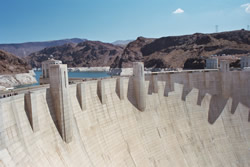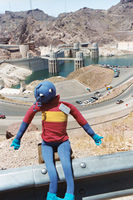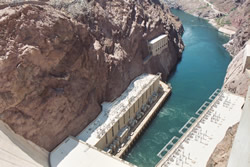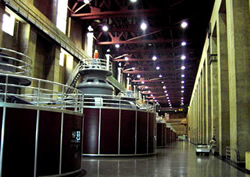A Report from Energy Ant— My Trip to the Hoover Dam near Boulder City, Nevada

On a hot summer day in Nevada, I headed to the Hoover Dam to learn all about how they get electricity from the moving water of the Colorado River.
My day began in Las Vegas, Nevada where I hopped on a bus to travel 30 miles out to Black Canyon to visit the Dam. I was told that Native Americans have been living in this area for centuries, but it wasn’t until the 1850s that trappers, gold miners, and explorers from the east came to the Colorado River. Many river explorers like Lt. Joseph Christmas Ives and John Wesley Powell hoped the river could be used for travel and to move goods.
However, they quickly discovered the river wouldn’t work for what they needed because the amount of water that flowed from the Colorado River was very different from season to season and year to year. Sometimes the water level was very high and it would flood valleys along the river; but other times there was drought and the river would be reduced to tiny trickles of water.
During the bus ride to the desert, I wondered how people survived during those droughts in such intense heat with no water— on the day of my journey, it was over 100° F! Hot enough to make my antennae droop.

When the bus arrived, the first thing I noticed was the size of the Dam. Boy, it was HUGE! The Hoover Dam stands 726 feet tall, which is almost 200 feet taller than the Washington Monument in Washington D.C.! And, it is really thick too. The base measures 660 feet wide, which is about the same size as two football fields measured from end to end!
I had to take an elevator to get from the top to the bottom of the Dam. The tour guide, Dan McRoberts, said that 4 ½ million cubic yards of concrete were used to build the Dam and this much concrete could pave a standard highway from San Francisco to New York City! WOW! The concrete wasn’t all poured at once though. When concrete is mixed, it creates an exothermic reaction—that means it gives off heat. In order to let the concrete cool, the Dam was built with interlocking blocks that were assembled into columns. The columns also had 1 inch steel pipes put inside them so that cold water could run through to help cool off the concrete. The spaces and cracks between the columns were filled with grout to make one giant wall.

This enormous project attracted people from all over the U.S. who traveled to Nevada to help build the Dam. The Hoover Dam was built during the Great Depression and it was completed in only five years—starting April 20, 1931, and completed on March 1, 1936. A total of 21,000 men were involved in the planning and construction of the Dam, and an average of 3,500 men worked on the Dam daily. Most of the workers also brought their families with them and they had to live without clean drinking water, toilets, or shelter from the extreme weather.
Building the Dam was very dangerous as well. Ninety-six men died while building the Hoover Dam from “industrial deaths,” including drowning, as a result of blasting and falling rocks or slides, falls from the canyon walls, truck accidents and even being struck by heavy equipment. And, if you include other deaths from heat exhaustion and heart problems—more than 200 men passed away while building this huge structure. All of the men who worked on Hoover Dam are considered heroes and are recognized in a variety of monuments at the site.
When I got off of the elevator, I put on a hard hat to protect myself while I walked through the tunnels and canyons in and around the Dam. More than 8.5 million pounds of dynamite were used to blast the foundation for the Dam to create the eight miles of tunnels though the canyon walls.
The water that flows through the Dam does not flow over the wall or under the wall, but it goes around the wall. There are two rows of generators, one on each side of the river.
There are four intake towers on the lake side of the Dam that let water into the penstocks. Penstocks are giant pipes that the water flows through—the ones at Hoover Dam are 30 feet wide and can carry enough water to fill 900 bathtubs in only one second. (You can see the penstocks above my head in the second picture.) When water goes from a higher elevation to a lower elevation through these penstocks, the force of the water creates energy. The water then flows through a turbine. The turbine is a giant wheel with fins on it. The force of the water makes the wheel spin. You can learn more about how a hydropower plant works in the Hydropower section of this site.

After looking at the turbines, I climbed a flight of stairs to see the generators with my own two eyes. Each turbine is connected to a generator by a giant pole called a shaft. In the generator, magnets are connected to the pole and are surrounded by a stationary coil of copper wire. When the very strong magnet spins, it displaces electrons in the copper wile, which generates electricity. At the Hoover Dam, there are seventeen generators. If all of the generators are working at full capacity, the Hoover Power Plant is able to produce 2,080 megawatts of power. (This includes the two station-service units that produce power just to run the machinery and power the lights at the Dam.) That is enough electricity to power a city of 750,000 people. That much energy could power 35 MILLION regular incandescent light bulbs.
The electricity produced by the generators of the Dam flows through transformers on its way to the city. Making the electricity at the Dam does not release air pollution into the air, nor does it produce any chemical runoff or toxic waste. However, since a Dam can only be built on a river, the electricity that is produced must be carried a long way to the cities where it will be used. Nineteen percent of the electricity from the Hoover Dam goes to Arizona, 23 percent goes to Nevada, and 58 percent goes to California. About 15 percent of the Dam’s electricity goes to Los Angeles —a city that is 270 miles away.
Another great thing about hydroelectric power is that the water that goes through the Dam can be used over and over again as it flows down the Colorado River, making hydroelectricity a renewable energy source.
There are many dams along the Colorado River, but not all of them produce electricity. In fact, the main reason the Hoover Dam was built and is operating today is not for its electricity production. The Hoover Dam and the other 50+ dams help control the Colorado River. That is, they control floods, irrigate crops, supply drinking water, make places for recreation, create habitat for wildlife, and generate electricity. Lake Mead, located behind the wall at Hoover Dam is the most important part of the Dam. It is the biggest man-made lake in the United States and provides drinking water to Los Angeles, San Diego, and Phoenix. Las Vegas gets almost all of its water from Lake Mead. While the electricity that Hoover Dam generates is important, living out here in the desert would be impossible without the flowing water of the Colorado River.


